My thanks to M. Smith for the photocopy of this paper.
Many of these, and additional pieces, are illustrated in Dalton &
Hamer.
TOKENS made of lead or pewter are scarce, because they have in general been disregarded by collectors as unworthy of their notice, and being of so little intrinsic value, they are usually thrown away by the person who finds them. They possess, however, some claim to be put on record as evidence of the state of the currency at particular times, when, owing to the scarcity of regal copper money, it became necessary to substitute leaden tokens for the convenience of the poorer classes of society.
All the tokens described in the following Catalogue are made of lead, except the Ballycastle halfpenny, which is made of pewter, and was struck with dies. The greater number of the leaden tokens were cast in moulds, and a few of them were subsequently countermarked with a stamp, bearing the initials of the person by whom they were issued.
There was an abundance of regal copper halfpence coined for Ireland between the years 1736 and 1783, but no copper farthings were issued after the year 1760, until 1806. The regal money must have become scarce soon after 1783, as a necessity arose for the coinage of a great variety of copper halfpence after the year 1789, a copious list of which has been published by Mr. Lindsay - "View of the Coinage of Ireland p.116"
The only tokens which bear dates are the curious one of Kilkenny, struck in 1578, and the square piece with the date 1731, the last in this Catalogue.
The period during which the Dublin tokens were current has been ascertained from a careful examination of the "Dublin Directories." It extended from the year 1773 to 1799, and nine of the sixteen Dublin tokens were in circulation between the years 1780 and 1790; most of them were issued by grocers who chiefly resided in obscure localities, viz.: Mary's-abbey, Boot-lane, Fisher's lane, Pill-lane, Church-street, Upper Church-street, and North Great Brunswick-street, all in the same neighbourhood ; and one in Britain-street, on the north side of the city; and on the south side in Francis-street, Thomas-street, and James's-street.
Most of the Cork tokens were also issued by grocers, as appears from the symbol of the sugarloaf, and more particularly from the local information respecting them for which I am indebted to Mr. Richard Caulfield of Cork. The period during which the Cork tokens were in circulation extended from the year 1795 to 1816.
It is probable that these tokens passed as farthings to accommodate the poorer classes in the purchase of small quantities of tea and sugar, which bore high prices during the protracted war with France.
Aquilla Smith - Leaden & Pewter Tokens
| BALLYCASTLE, CO. ANTRIM.
|
top
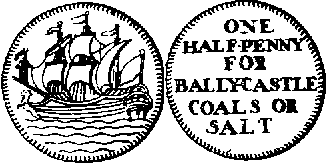
Illustration from Simon
|
| 1.
|
| A ship with all her sails set, sailing to the left, within a beaded circle, close to the edge of the coin.
|
| ONE - HALF-PENNY - FOR - BALLYCASTLE - COALS OR - SALT in six lines, within a beaded circle. It weighs 94 grains.
|
Coal was worked at an early period on the coast near Ballycastle, and saltpans were in operation in the same neighbourhood during the last century. The coal-mines were held by a company mostly composed of Englishmen, previous to the year 1736, at which time the Earl of Antrim granted them in perpetuity to Hugh Boyd, Esq. (Statistical Survey of the County of Antrim. p.82) Snelling published this token in his second additional plate to Simon, about the year 1769, and, having described a few of the copper tokens which were issued in the North of Ireland, in 1736, added:-"It is very probable that about this time No.23 was struck, which is made of lead."
This token, which is of good workmanship, and made of pewter, was probably issued by Mr. Boyd, shortly after the year 1736, for the convenience of the poor at Ballycastle.
|
| CLONMEL, CO. TIPPERARY.
|
top
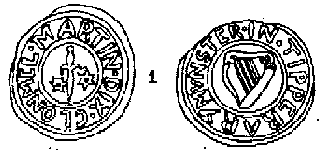
|
| 2.
|
| MARTIN . DIX . CLONMEL, within a double circle; in the centre a dagger, pointing downwards; at each side of it a pierced mullet of six points.
|
| IN . TIPPERARY . MVNSTER . , within, a double circle; in the centre a harp. Weight 59 grains. Fig. 1.
|
| This coin in type and size resembles many of the tradesmen's tokens of the seventeenth century; it was probably issued between the years 1656 and 1664, the date which occur on the Clonmel tokens. The letter "v" is used instead of "u" in Munster, a peculiarity which distinguishes it from all the other leaden tokens, except the one of Kilkenny, with the date 1578.
|
top
|
| 3.
|
| Same as No.2.
|
| IN . TIPPERARY . MVN, within a double circle; in the centre a harp. Weight 45 grains.
|
| -
|
| CORK, CO. CORK.
|
top
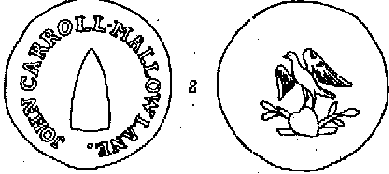
|
| 4.
|
| JOHN CARROLL MALLOW LANE. A sugarloaf in the centre.
|
| A bird with expanded wings resting on a heart, at each side of which is a sprig of olive. Weight 121 grains.
|
| John Carroll was a grocer and baker. Fig. 2.
|
top
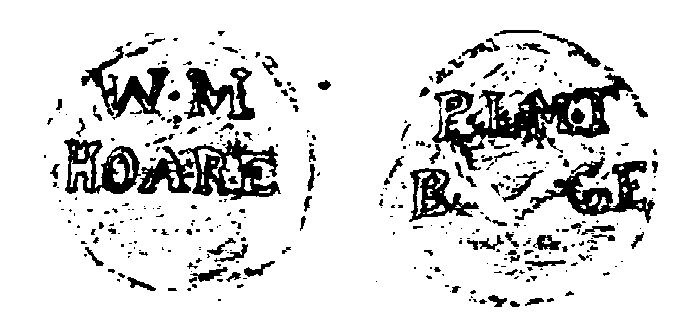 Aq. Smith Aq. Smith
|
| 5.
|
| W M - HOARE, in two lines across the field.
|
| P. L. M. T - BRIDGE, in two lines. Weight 145 grains.
|
| This token was dug up at Friar's Walk, near Cork, in April, 1844. It was issued by "William Hoare," a grocer, who resided at the George's-quay side of "Parliament Bridge," in the year 1810.
|
top
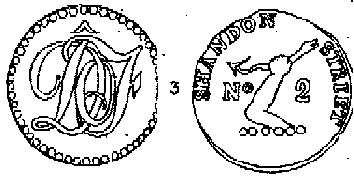
|
| 6.
|
| D O F, Script capitals in cipher, within a beaded circle close to the edge.
|
| SHANDON STREET. In the centre a crest, viz., an arm, couped above the elbow, holding a snake, between No. and 2. Weight 118 grains. Fig. 3.
|
| This token was issued by Denis O'Flynn, whose son and successor was a Town Councillor of Cork in 1854. About the year 1795 these tokens were first issued by the late Mr. O'Flynn, who continued to circulate them for many years afterwards. I am indebted to Mr. Richard Caulfield for a token cast in the original brass mould, at his request, by Mr. O'Flyun, in the year 1856.
|
top
|
| 7.
|
| A. L. in Script capitals.
|
| A sugarloaf suspended from a ring, between Bk and St (Barrack-street); an olive-branch above, and another below the sugarloaf. Weight 128 grains.
|
| This token was issued by Andrew Lucette, a grocer, who resided in Barrack-street about the year 1808. Engraved in Lindsay's " View of the Coinage of Ireland," Supplement, pl. V. fig. 18.
|
top
|
| 8.
|
| A sugar-loaf between the letters F.M . in Roman capitals; a circle of pellets near the edge.
|
| An eagle with expanded wings, within a circle of pellets. Weight 88 grains.
|
| Engraved in Lindsay, Supplement, pl. V. fig. 17. Frederick Miller, a grocer, who resided in Barrack-street about the year 1808, issued this token.
|
top
|
| 9.
|
| I. D. in Script capitals, within a circle of pellets.
|
| A sugarloaf suspended from a ring, between Bk and ST, (Barrack-street), within a circle of pellets. Weight 141 grains.
|
| John Drinan, a grocer, who issued this token, resided in Barrack-street about the year 1808.
|
top
|
| 10.
|
| IOHN . HARE.
|
| BARRACK STREET. A circular token described by Mr.Lindsay, "View of the Coinage of Ireland," p.120.
|
| John Hare was a grocer in Barrack-street in the year 1816; he afterwards removed to Patrick-street.
|
| DUBLIN, CO. DUBLIN.
|
top
|
| 11.
|
| JOHN BOSHELL. In the centre a flower with six petals.
|
| No 83 - CHURCH - STt. in three lines; weight 75 grains.
|
| John Boshell was in business as a grocer at 83, Old Church-street, from the year 1781 until 1786, at which time he appears to have been an oil and seed merchant; and in 1788 he was a wholesale merchant; his name does not appear in the " Dublin Directory" after the year 1789.
|
top
|
| 12.
|
| P- BYRNE -No. 28, in three lines; milled on the edge.
|
| Ch. -Strt. in two lines; weight 131 grains.
|
| Patrick Byrne, grocer, resided at No. 28, Old Church-street from the year 1779 until 1792 ; his name is omitted in the "Directory" for the year 1786.
|
top
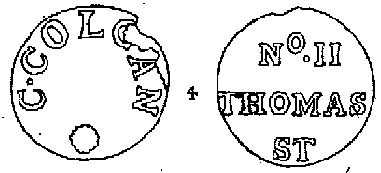
|
| 13.
|
| C . COLGAN.
|
| No 11 - THOMAS - ST. in three lines; weight 115 grains. Fig. 4.
|
|
|
top
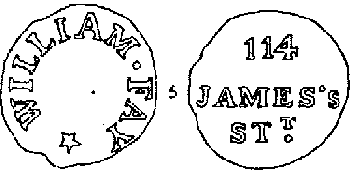
|
top
|
| 14.
|
| WILLIAM . FAY+
|
| 114 - JAMES'S - STt. in three lines; weight 80 grains. Fig. 5.
|
| William Fay, grocer, is in the "Directory" for the years 1798 and 1799.
|
top
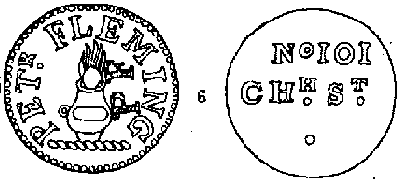
|
top
|
| 15.
|
| PETr FLEMING. In the centre an urn, with a loop at each side, and flames issuing from the urn; the letters P. F. stamped in as a counter-mark.
|
| No. 101 - CHh. St. in two lines: weight 108 grains. Fig. 6.
|
| Peter Fleming, grocer, is in the "Directory" from the year 1776 to 1786, when he was succeeded by Patrick Rooney (see No.22), whose name is in the "Directory" for the year 1787, as residing in No.101, Old Church-street.
|
top
|
| 16.
|
| CHRr - HALPIN in two lines.
|
| CHURCH STt.; in the centre 89; weight 103 grains.
|
| Christopher Halpin, grocer, resided in No.39, Old Church-street, from the year 1787 to 1793.
|
top
|
| 17.
|
| * * * : HUTTON, in the centre a double circle, with four small crosses at equal distances between the two circles.
|
| JAMES . STREET ; in the centre, 101; a bird (?) over the figures; weight 72 grains.
|
| Maxwell Hutton, No. 131, James's-street, is in the "Directory" from the year 1787 to 1790. The Hutton family carried on the grocery business for many years subsequent to 1790. There is a street in Dublin called Dame's-street, which at first was put on the mould, and altered to James-street.
|
top
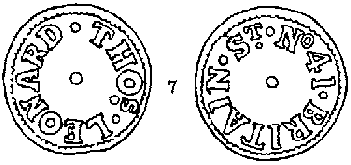
This appears to be the variety.
|
| 18.
|
| THOs. . LEONARD.; in the centre a flower of six petals.
|
| No. 41 BRITAIN St; in the centre a flower of six petals weight 52 grains. Fig. 7.
|
|
|
top
|
| 18v.
|
| There is another variety, which has a small pellet in the centre, instead of a flower, on each side; weight 52 grains.
|
|
|
| Thomas Leonard, grocer, resided at No.41, Britain-street, now called Great Britain-street, from the year 1779 to 1783.
|
top
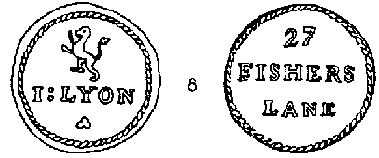
|
| 19.
|
| I : LYON across the field. A lion rampant over the name, and a trefoil under the name, within a roped circle near the edge.
|
| 27 - FISHERS - LANE in three lines, within a roped circle weight 53 grains. Fig. 8.
|
| Fisher's-lane is an obscure place between Pill-lane and Mary's-lane.
|
top
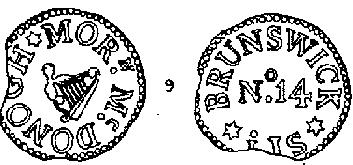
|
| 20.
|
| * MORn Mc. DONOGH; in the centre a harp; at the edge a beaded circle.
|
| * BRUNSWICK * STt.; in the centre, No. 14; at the edge a beaded circle; weight 53 grains. Fig. 9.
|
| Brunswick-street, now called North Brunswick-street, is adjacent to Upper Church-street.
|
top
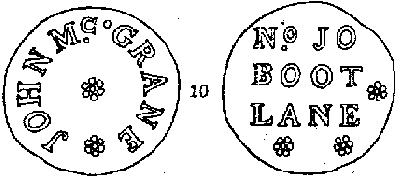
|
| 21.
|
| JOHN Mc. . GRANE; a flower of six petals in the centre, and a similar flower between the name and surname.
|
| No. J0 -BOOT - LANE in three lines, a flower of six petals near the margin after "Boot," and two similar flowers under "Lane." Fig. 10.
|
| Boot-lane extends from Mary's-abbey to Little Mary-Street.
|
top
|
| 22.
|
| PAT - ROONEY in two lines; between the lines a sprig.
|
| No. 101 - CHh. . St. in two lines ; a scroll under the lower line; weight 88 grains.
|
| Patrick Rooney, grocer, resided at No. 101, Old Church-street, from the year 1787 to 1790; he was the successor of Peter Fleming, No.15.
|
top
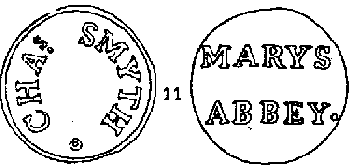
|
| 23.
|
| CHAs. SMYTH a small annulet after the surname.
|
| MARY'S-ABBEY. in two lines; weight 75 grains. Fig.11.
|
| Mary's-abbey extends from Capel-street to Pill-lane.
|
top
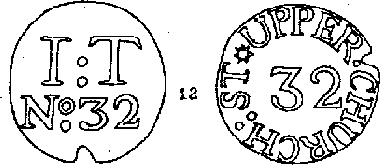
|
| 24.
|
| I : T - No. 32 in two lines.
|
| UPPER . CHURCH : ST. *; in the centre 32; weight 103 grains. Fig. 12.
|
| John Taylor, grocer, resided at No. 32, Upper Church-street, which is a continuation of Old Church street, from the year 1787 to 1791.
|
top
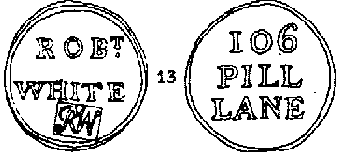
|
top
|
| 25.
|
| ROBt. - WHITE in two lines, countermarked with the initials, R. W. in Script characters on a rectangular label.
|
| 106 PILL-LANE in three lines; weight 86 grains. Fig. 13.
|
| Robert White, grocer, resided at No.106, Pill-lane, from the year 1773 to 1784.
|
top
|
| 26.
|
| ASHLEY - BLUE BOAR - FRANs. STt. in three lines within a raised border.
|
| Blank; weight 80 grains.
|
| William Ashley, grocer, resided at No. 77, Francis-street, in the year 1797.
|
| KILKENNY, CO. KILKENNY.
|
top
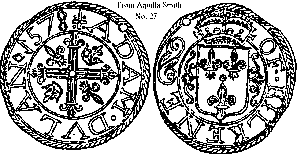 Illustrated in the text. Illustrated in the text.
|
top
|
| 27.
|
| ADAM . DVLAN . 1578 around a central cross with fleur de lys and crowns in alternate corners
|
| OF . KILKENE a scroll, around a crowned shield bearing three fleur de lys.
|
| This rare and curious piece struck at Kilkenny in 1578 has been already described in the second volume of the "Transactions of the Kilkenny Archaeological Society," page 171. In Seaby's Coins and Tokens of Ireland, a photo of this is illustrated, with the comment that it is the only Irish token which can be positively attributed to the 16th century. It notes that it is basically that of a type of the French ecu d'or (which also bears the arms of France on the rev.), and it is possible that the issuer was a vintner who imported wines from France. Now in the British Museum, ex. Lionel Fletcher collection.
|
| LOCALITY NOT ASCERTAINED.
|
top
|
| 28.
|
| M.
|
| Plain. A circular piece.
|
|
|
top
|
| 29.
|
| F O D stamped in.
|
| Plain. An oblong piece.
|
|
|
top
|
| 30.
|
| I . S stamped in
|
| Plain. An irregular lump.
|
|
|
top
|
| 31.
|
| Seems W. S. E. very deeply stamped in.
|
| Plain. An irregular lump.
|
| These four tokens are described by Mr. Lindsay, who states that they were struck in Cork "between 1809 and 1813," but the persons who issued them have not been idenitified.
|
top
|
| 32.
|
| T . A; a circle of pellets near the margin.
|
| A fox seated within a raised border; weight 164 grains.
|
|
|
top
|
| 33.
|
| H L; a dentated circle near the margin
|
| A bell, a pellet at each side, and another below the bell, within a dentated circle; weight 52 grains.
|
|
|
top
|
| 34.
|
| A tower within a beaded circle.
|
| V . I within a beaded circle; weight 37 grains.
|
|
|
top
|
| 35.
|
| D O B stamped in an oblong label, with an engrailed border.
|
| blank; weight 79 grains.
|
|
|
top
|
| 36.
|
| T D - F in large Roman capitals in two lines.
|
| Blank; weight 120 grains.
|
|
|
top
|
| 37.
|
| K F in beaded circle near the margin.
|
| Blank; weight 48 grains.
|
|
|
top
|
| 38.
|
| 2d; a large figure within a plain circle.
|
| blank; weight 76 grains.
|
|
|
top
|
| 39.
|
| TYRREL - No 9 T . C in two lines within an engrailed border.
|
| Blank; weight 82 grains.
|
| This is an oblong piece, with the angles cut off; the impression of the stamp extends to the margin of the piece on all sides. The letters T . C possibly signify "Thomas-court," an obscure place in Dublin, on the south side of the city, and in the vicinity of the other streets in which tokens were issued.
|
top
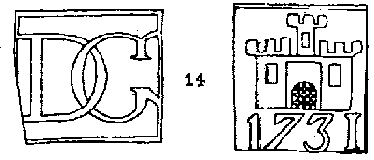
|
| 40.
|
| D G in large Roman characters, interlaced.
|
| A castle with three towers; 1731 in large figures under the castle; weight 87 grains. Fig. 14.
|
|
|
| This remarkable square piece is in the cabinet of William Leycester, Esq., of Cork.
|



 Aq. Smith
Aq. Smith











 Illustrated in the text.
Illustrated in the text.
